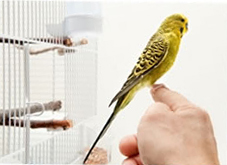Birds
Birds
Needs
Magpie Robins, Yellow-fronted Canaries, Small Pratincoles, Silver-eared Mesias, Peking Nightingales and Budgerigars are some of the most common types of pet birds kept in Hong Kong.
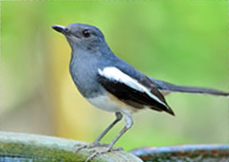
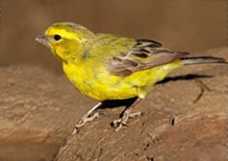
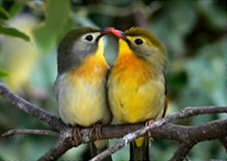
Here's a simple checklist to assist you in taking proper care of your bird.
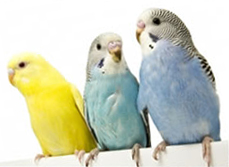
- Water bowl
- Food bowl
- Aviary or cage (with metal bars and cage cover)
- Perches
- Bird bath or spray bottle
- Mineral blocks (for calcium and trimming of beak)
- Grit (for some birds)
- Nail clipper
- Toys
- Access to clean and fresh water
- Adequate and nutritious food
- Registered veterinarian consultation for regular checkups or medical treatment when the bird is sick/injured
Above all, remember your bird needs tender loving care.
Feeding
Different types of birds eat different things. Some birds are omnivores which means they eat both plants and animal protein such as mealworms and crickets. Others are herbivores which means they eat plants, fruits and seeds. Consult a veterinarian for appropriate and complete diet recommendation. Beware that birds can throw the husks of seed back into the bowl. Please make sure the food bowl is cleaned and seeds are refilled. Also consult a veterinarian if you are unsure about the amount of fruit that can be fed. Excess or stale fruit can lead to diarrhoea. A mineral block can be important to some birds. Please check with the breed appropriateness. Other birds may need grit (sand-like material) for digestion. Please also check with your veterinarian.
Supply your bird with clean, fresh water at all times. Use a water bowl that can be mounted on the cage. Change the water in the water bowl daily and wash the water bowl frequently.
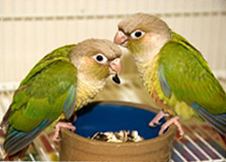
How often should I feed my bird?
Feed your bird two times a day, once in the morning and once at night. Feed it at about the same time each day as birds like routine. Morning and night feeding also imitates conditions in the wild and will make your bird healthier overall.
How much should I feed my bird?
Feed your bird a little in the morning and a little at night so that it will eat most of what you give. Avoid giving an excessive amount of feed otherwise your bird may become a picky eater or become overweight.
What kind of food bowl to use?
It’s best to use heavy food bowls made of stainless steel or ceramic to avoid spillage. Plastic ones are too light and flimsy and are likely to be chewed or picked up and tossed about by birds unless they are mounted on the cage. Make sure you wash your bird’s food bowl frequently.
Accommodation
Provide your bird with a large cage with metal bars. The cage should be roomy enough for your bird to stretch its wings and fly short distances. The bar spacing of the cage should be smaller than your bird’s head.
Put a food bowl, a water bowl, a bath, perches, mineral blocks and toys in the cage.
Perches and toys are important. Perches provide standing places for your bird and allow it to exercise its feet and keep its nails and beak trim. Choose perches with different shapes and sizes but make sure they all fit your bird’s feet. You may consider perches made of wood.
Toys enrich your bird’s environment. Some common bird toys include balls, bells, chains, ladders, mirrors and ropes. Give your bird a variety of toys with different colours, shapes, sizes and textures to keep it stimulated. Make sure the toys are made from non-toxic materials. If in doubt, consult your vet about the appropriate types of toys for your bird.
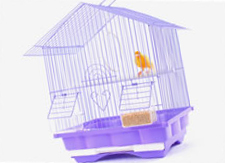
Put the cage in a well-lit, well-ventilated place indoors, out of direct sunlight and free from direct draft. To make your bird feel comfortable and secure, put the cage against a wall or in a corner and preferably higher off the ground.
Cleaning & Grooming
As birds like routine, try to clean your bird’s cage every day at the same time and in the same way. Place newspapers at the bottom of the cage for easier waste disposal. Disinfect the cage weekly.
Birds clean themselves by using their beaks to run through their feathers. Some also enjoy taking baths in shallow pools. Put a bath (a shallow water basin) at the bottom of the cage for your bird to bathe in. Alternatively, you could spray them gently with a spray bottle 2 to 3 times a week.
Learn how to trim your bird’s nails from a vet. You may need to trim its nails if they grow too long.
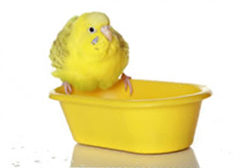
Interaction
Birds are creature of habit. They like things to remain the same in their home. Therefore, avoid making changes to your bird’s home. If you really need to make changes, try to do it bit by bit.
Birds can get stressed easily if they meet strangers or other birds. They may fall sick if they feel stressed. To help your bird get familiar with you, talk to it gently and patiently. Spend time to bond with your bird daily to earn its trust.
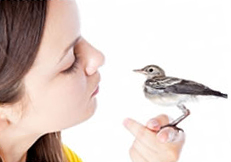
Training
Some birds are really intelligent and inquisitive and you can train them to do tricks. Other birds such as the parrot can be trained to talk. Some birds can be trained to sit or perch on your finger but you will need to be very patient with your bird and train it step by step. Begin by holding out food to it so that it gets used to your hand. Do not make any sudden movements near your bird or you will frighten it.
